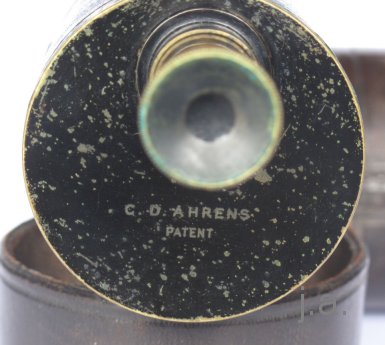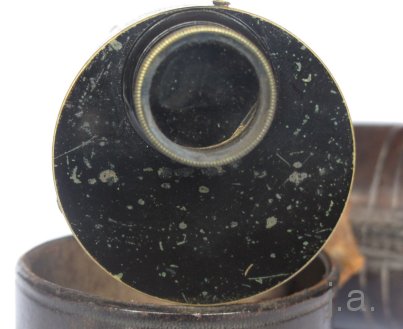C.D. Ahrens Monocular
| Das hier gezeigte Monokular ist ein Versuchsmodell für ein Porro-1-Monokular des deutschstämmigen, aber in England lebenden, Carsten Diederich Ahrens. Es könnte zwischen 1880 und 1914 gefertigt worden, der aktiven Schaffensperiode von Ahrens. Die einfache Bauweise unter Nutzung eines belederten zylindrischen Gehäuses mit Befestigungsplatten für zwei Porro 1 Prismen im Inneren sowie dem eher astronomischen oder Mikroskop-Okular lassen jedoch auf eine Erstellung bereits von dem ersten Zeiss-Porro-Glas von 1893 schliessen (vgl. anderer Porro 1 Prototyp. Ahrens hatte ein Patent zur "Verbesserte Konstruktion von Prismen", das in England allerdings erst 1911 angenommen wurde. Ein Doppel-Fernrohr bzw. Fernglas mit Porro-Prismen existiert auch von Ahrens und stammt aus der Zeit um 1890 (vgl. Louwman "A Certain Instrument for Seeing far", Wassenaar, 2013, S. 213; Foto hier). | The monocular depicted here is a prototype of a porro 1 monocular made by the German born Carsten Diederich Ahrens living in England. It might be made between 1880 and 1914, the active working time of Ahrens. The simple design using a leather-covered cylindrical housing with mounting plates inside for the two porro 1 prisms as wel las the rather astronomical or microscope eyepiece look more like a production time efore the first Zeiss prism glass in 1893 (cf. another porro 1 prototype. Ahrens held a patent on "Improved Construction of Optical Prisms" which was accepted in England in 1911. A double telescope or binocular with porro prisms was also made by Ahrens dating around 1890 (cf. Louwman "A Certain Instrument for Seeing far", Wassenaar, 2013, p. 213; a photo can be seen here.). |




| Das Monokular ist 100-125mm lang. Das 68mm lange Gehäuse ist 47mm, das Okular 18mm und das Objektiv 24mm im Durchmesser. | he monocular is 100-125mm long. The 68mm long housing is 47mm, the eyepiece 18mm, and the objective 24mm in diameter. |
Fotos: J. Ahrens

